
Easter Island is an island and special territory of Chile in the southeastern Pacific Ocean, at the southeasternmost point of the Polynesian Triangle in Oceania. The island is most famous for its nearly 1,000 extant monumental statues, called moai, which were created by the early Rapa Nui people. In 1995, UNESCO named Easter Island a World Heritage Site, with much of the island protected within Rapa Nui National Park.

In botany, a drupe is an indehiscent type of fruit in which an outer fleshy part surrounds a single shell of hardened endocarp with a seed (kernel) inside. These fruits usually develop from a single carpel, and mostly from flowers with superior ovaries.

The Valparaíso Region is one of Chile's 16 first order administrative divisions. With the country's second-highest population of 1,790,219 as of 2017, and fourth-smallest area of 16,396.1 km2 (6,331 sq mi), the region is Chile's second most densely populated after the Santiago Metropolitan Region to the southeast. The region also includes Chile's remote islands of the Pacific Ocean, including Rapa Nui and the Juan Fernandez Islands.

The Rapa Nui are the indigenous Polynesian peoples of Easter Island. The easternmost Polynesian culture, the descendants of the original people of Easter Island make up about 60% of the current Easter Island population and have a significant portion of their population residing in mainland Chile. They speak both the traditional Rapa Nui language and the primary language of Chile, Spanish. At the 2017 census there were 7,750 island inhabitants—almost all living in the village of Hanga Roa on the sheltered west coast.
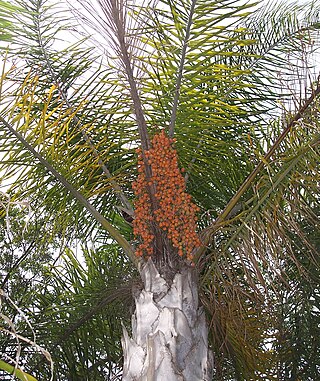
Syagrus is a genus of Arecaceae (palms), native to South America, with one species endemic to the Lesser Antilles. The genus is closely related to the Cocos, or coconut genus, and many Syagrus species produce edible seeds similar to the coconut.

Avellanita is a monotypic plant genus of the family Euphorbiaceae. The sole species is Avellanita bustillosii, endemic to Chile. A specific locus of occurrence is in the La Campana National Park of central Chile and amid the adjoining Cerro La Campana and in the Laguna Aculeo area and its southern distribution is located in Chancon, close to Rancagua. Regarding the use of its seeds, it has been pointed out that its "small hazelnuts" are edible.

Jubaea is a genus of palms with one species, Jubaea chilensis, commonly known in English as the Chilean wine palm or Chile cocopalm, and palma chilena in Spanish. It is native to southwestern South America and is endemic to a small area of central Chile between 32°S and 35°S in southern Coquimbo, Valparaíso, Santiago, O'Higgins, and northern Maule regions.
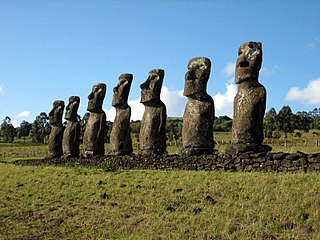
Rapa Nui National Park is a national park and UNESCO World Heritage Site located on Easter Island, Chile. Rapa Nui is the Polynesian name of Easter Island; its Spanish name is Isla de Pascua. The island is located in the southeastern Pacific Ocean, at the southeastern extremity of the Polynesian Triangle. The island was taken over by Chile in 1888. Its fame and World Heritage status arise from the 887 extant stone statues known by the name "moai", whose creation is attributed to the early Rapa Nui people who inhabited the island starting between 300 and 1200 AD. Much of the island has been declared as Rapa Nui National Park which, on 22 March 1996, UNESCO designated a World Heritage Site under cultural criteria (i), (iii), & (v). Rapa Nui National Park is now under the administrative control of the Ma´u Henua Polynesian Indigenous Community, which is the first autonomous institute on the island. The indigenous Rapa Nui people have regained authority over their ancestral lands and are in charge of the management, preservation and protection of their patrimony. On the first of December 2017, the ex-President Michelle Bachelet returned ancestral lands in the form of the Rapa Nui National Park to the indigenous people. For the first time in history, the revenue generated by the National Park is invested in the island and used to conserve the natural heritage.

Attalea is a large genus of palms native to Mexico, the Caribbean, Central and South America. This pinnately-leaved, non-spiny genus includes both small palms lacking an aboveground stem and large trees. The genus has a complicated taxonomic history, and has often been split into four or five genera based on differences in the male flowers. Since the genera can only be distinguished on the basis of their male flowers, the existence of intermediate flower types and the existence of hybrids between different genera has been used as an argument for keeping them all in the same genus. This has been supported by recent molecular phylogenies.

The Chilean tinamou is a type of tinamou commonly found in high elevation shrubland in subtropical regions of central Chile.

Latania, commonly known as latan palm or latania palm, is a genus of flowering plant in the palm tree family, native to the Mascarene Islands in the western Indian Ocean.
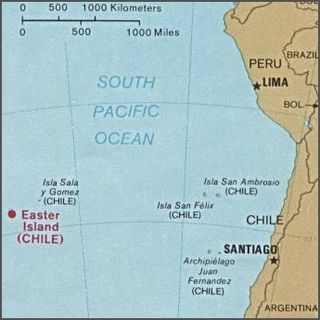
Geologically one of the youngest inhabited territories on Earth, Easter Island, located in the mid-Pacific Ocean, was, for most of its history, one of the most isolated. Its inhabitants, the Rapa Nui, have endured famines, epidemics of disease, civil war, environmental collapse, slave raids, various colonial contacts, and have seen their population crash on more than one occasion. The ensuing cultural legacy has brought the island notoriety out of proportion to the number of its inhabitants.

Kerriodoxa elegans, the white backed palm, is the only species of palm tree in the genus Kerriodoxa, in the family Arecaceae.

Palm syrup is an edible sweet syrup produced from the sap of a number of palms. It is produced in the Canary Islands and coastal regions of South America.
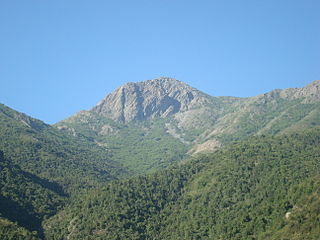
Cerro la Campana, the Bell mountain, is a mountain in La Campana National Park in central Chile. The Pacific and the mountain Aconcagua are visible from the summit on clear days.

Porlieria chilensis is a plant that occurs in South America. In fact, all genus members are small trees or shrubs found on the South American continent. An example occurrence of P. chilensis is in the arid forested area of central Chile, where it occurs in association with the endangered Chilean wine palm, Jubaea chilensis.
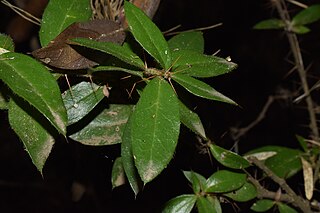
Dasyphyllum excelsum is a species of flowering plant in the family Asteraceae. This species is endemic to Chile, occurring from Quillota to Cauquenes between 190 and 800 m above sea level, a specific location of occurrence being in central Chile within the Cerro La Campana forests in association with the endangered Chilean wine palm, Jubaea chilensis.
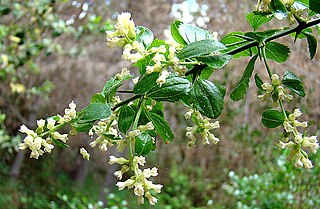
Retanilla trinervia is a species of actinorhizal plant within the family Rhamnaceae; this dicotyledon flora is a shrub or small tree. R. trinervia is notable for its ability to fix nitrogen. This species mainly occurs in the near coastal forests and arid shrubland of Chile. Example occurrences are found in the mountains of central Chile; for example, it occurs in the La Campana National Park in association with Acacia caven and Jubaea chilensis. as well as other proximate areas of central Chile.
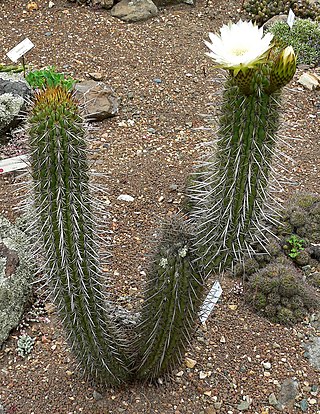
Leucostele chiloensis is a species of cactus native to South America; genus members are known as hedgehog cacti, sea-urchin cactus or Easter lily cactus.

Easter Island is one of the world's most isolated inhabited islands. Its closest inhabited neighbours are the Chilean Juan Fernandez Islands, 1,850 km (1,150 mi) to the east, with approximately 850 inhabitants. The nearest continental point lies in central Chile near Concepción, at 3,512 kilometres (2,182 mi). Easter Island's latitude is similar to that of Caldera, Chile, and it lies 3,510 km (2,180 mi) west of continental Chile at its nearest point. Isla Salas y Gómez, 415 km (258 mi) to the east, is closer but is uninhabited. The Tristan da Cunha archipelago in the southern Atlantic competes for the title of the most remote island, lying 2,430 km (1,510 mi) from Saint Helena island and 2,816 km (1,750 mi) from the South African coast.



















